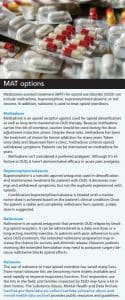Perioperative considerations nurses need to know for elective surgery.
Takeaways:
- Nursing care requires familiarization with medication-assisted treatment (MAT) for opioid use disorders, as well as adjuvant analgesia for safe post-operative pain management for these patients.
- Nurses must understand the interactions/precautions of MAT in all phases of perioperative care.
Anesthesia and analgesia have used opium and opium compounds for thousands of years. However, by the end of the 20th century, overuse and misuse of opioids, leading to opioid addiction and opioid use disorders (OUDs), had begun to overshadow the advantages of this treatment, with a demonstrable surge of opioid use at the beginning of the 21st century. In addition to misuse and tolerance, opioid overdose deaths have skyrocketed. Opioid abuse in the United States has grown to epidemic proportions. In 2017, according to the U.S. Department of Health and Human Services (HHS) and the Center for Behavioral Health Statistics and Quality, about 1.7 million people suffered from OUD, and the United States declared a national public health emergency.
One consequence of the opioid epidemic is that opioid tolerance, dependence, and addiction have become more common in the perioperative patient population, which can affect anesthetic and analgesia management. Many patients with OUD receive medication-assisted treatment (MAT). Nurses should be knowledgeable about MAT and understand how the drugs used in this treatment may affect postoperative pain interventions.
Medication-assisted treatment
The urgency to treat OUD underscores the essential need for expanded access to addiction treatment. When OUD, opioid dependence, or addiction is diagnosed, evidence from HHS demonstrates that MAT, combined with psychosocial therapies and community-based recovery support, is the most successful option and the gold standard for treating opioid addiction.
Successfully managing OUD includes detoxification from the substance (with safe supervision) and control of withdrawal symptoms. MAT programs are offered in the community, in outpatient settings, in partial hospital programs, and in residential treatment sites. These comprehensive programs include prescribing medication and supervising its use, as well as providing behavioral therapy and support. MAT aims to reduce withdrawal symptoms and diminish the craving for the opioid to prevent relapse.
Four medications are used in MAT—methadone, naltrexone, buprenorphine, buprenorphine/naloxone, and naloxone (to treat overdose). Research on the pharmacologic options for MAT hasn’t revealed one medication to be superior to the others. However, when a drug is prescribed with accompanying psychosocial therapy and is used correctly, each has had some success. (See MAT options.)


MAT maintenance is the longest phase of treatment. In this phase, individuals receive MAT for several months, years, or indefinitely. Those actively engaged in treatment can continue activities of daily living, including employment and childcare. Evidence from the Surgeon General’s 2018 report Facing Addiction in America: The Surgeon General’s Spotlight on Opioids suggests that individuals who receive MAT for fewer than 3 years are more likely to relapse than those who participate for 3 years or more.
Relapse is extremely high in patients receiving medically supported withdrawal alone, so they should participate in a formal drug rehabilitation program that includes therapy.
Patients with OUD and elective surgery
The perioperative phase is a vulnerable time for patients at any stage of OUD treatment. They frequently feel stigmatized, fearful of judgmental healthcare providers, and concerned that they may not be treated fairly. In addition to shame, patients with OUD may have opioid tolerance and increased sensitivity to pain, and they may be apprehensive about adequate analgesia postoperatively or relapsing. Treating postoperative surgical pain in a patient with a previous OUD who is receiving MAT can be challenging. It’s best accomplished with open communication, an understanding of MAT medications, and knowledgeable nursing care and planning.
History and assessment
Preoperative pain management guidelines recommend a thorough pain history, a physical exam and identification of comorbid conditions, psychiatric disorders, and other substances or medications that may cause withdrawal. Patients with OUD who also have anxiety or depression may use other substances, such as alcohol, and may be at risk for withdrawal while recovering from anesthesia or surgery. Many organizations use urine toxicology testing and online prescription medication drug monitoring to review for controlled substances.
Communication and education
Verify that the patient is participating in MAT by contacting their treatment program. Confirm MAT dosages, evaluate the patient’s treatment progress, and inform the program of the upcoming surgery. In addition, work with the patient to schedule a postoperative appointment with the treatment program, review the postoperative pain plan, provide education, and clarify expectations with the patient and their support system. Offering this information upfront may reduce anxiety, as patients and families may be concerned about an OUD relapse. Anxiety is a known drug-craving trigger that increases the risk for opioid misuse in patients with any substance use disorder.
Patients and their caregivers require education about the postoperative pain management plan, goals, and types of treatment that will be used. The outpatient MAT program or prescriber should be involved in these discussions. Relapse potential should be explored as well as the patient’s preferences, fears, beliefs, and prior acute pain experiences. Depending on the surgical procedure and severity of pain, discuss using nonpharmacologic interventions and nonopioid medications. For procedures where moderate-to-severe pain is anticipated, peripheral, regional, or neuraxial analgesia (such as nerve blocks or patient-controlled analgesia pumps) may be necessary to manage pain. However, adjunct nonopioid medications and nonpharmacologic options also should be considered. Multimodal analgesia—including gabapentin, nonsteroidal anti-inflammatory medications, I.V. acetaminophen, and low-dose ketamine—is becoming more common.
Throughout the continuum of care, monitor patients for pain as well as any signs or symptoms of withdrawal, cravings, and anxiety. All communication with the patient should be reassuring and empathetic and allow the patient some control.
Pain management based on drug regimen
The type of MAT a patient is prescribed—methadone, buprenorphine/naloxone, or naltrexone—will dictate postoperative pain management.
Methadone
Methadone maintenance for OUD should be continued after it’s verified with the patient’s MAT program. However, the daily methadone dose won’t be adequate for acute postoperative pain management. Patients will require additional medications and strategies.
Closely monitor these patients for adequate pain control as well as side effects, such as sedation and euphoria. In patients with cardiac comorbidities, monitor for ECG changes, as those receiving methadone may have a prolonged corrected QT interval. In addition, patients receiving methadone are at higher risk for respiratory complications.
Buprenorphine/naloxone
Advice about preoperative management of buprenorphine/naloxone is conflicting. Some experts recommend stopping the medication, while others recommend continuing it until the day of surgery. Buprenorphine/naloxone is a lifesaving medication for patients with OUD, so stopping it requires careful evaluation of the risks and benefits. Evidence from a systematic review by Sordo and colleagues indicates that mortality is substantially higher immediately after stopping buprenorphine/naloxone treatment compared to patients who continue it. Stopping treatment places patients at high risk of opioid overdose or resumption of opioid abuse, so the focus is on continuing treatment perioperatively.
According to Tung and colleagues, outcomes are better with continued treatment and the perioperative administration of adjunct opioid medications. Debate about this continues, but most protocols suggest that if buprenorphine/naloxone is stopped, it should be done 5 days before surgery with a transition to short-acting opioids. If MAT is stopped, an acute pain or addiction specialist should resume it as soon as possible.
Naltrexone
Naltrexone is an opioid agonist, which makes postoperative pain management in patients receiving this medication for OUD treatment challenging, especially in those treated with the long-acting injected formulation. Naltrexone blocks opioid analgesics, so the daily oral formulation should be discontinued 72 hours before surgery. If the medication isn’t stopped before surgery, standard opioid doses may not provide effective pain management. However, patients who discontinue naltrexone preoperatively may have a higher sensitivity or exaggerated response to opioids.
Consult with the outpatient treatment program or a pain specialist to establish a pain treatment plan. Depending on the surgery and the anticipated postoperative pain, consider regional analgesia, systemic nonopioids, and nonpharmacologic interventions. Postoperative patient education and support are essential. Assess patients for altered opioid responses as well as withdrawal and anxiety. These patients are at increased risk for overdose, so monitor them to ensure they resume MAT after discharge.
Nursing implications
The increased prevalence of OUD and MAT requires that nurses be knowledgeable about the medications used in this treatment, as well as the associated drug interactions and precautions when managing postoperative pain. Ineffective pain management in these patients is associated with relapse. Advocate for nonopioid and nonpharmacologic interventions, which can be effective at reducing a patient’s need for postoperative opioids. Monitor patients for acute pain, an exaggerated pain response, withdrawal from opioids, or postoperative respiratory depression.
As part of the patient’s discharge plan, ensure they resume MAT. Help bridge the gap between inpatient pain management and the MAT program. Facilitate open communication with the patient, caregivers, and MAT program or provider to reduce the risk of relapse and ensure adequate pain control.
Pursue education about OUD and MAT to help reduce its stigma. Be cognizant of your verbal and nonverbal communication when caring for patients receiving MAT, and avoid labeling or pre-judging patients. When you support patients, treat them with dignity, and focus on positive steps, you can profoundly change how patients feel about themselves.
Compassion and understanding
Measures are being taken to reduce OUD in the United States, but until it’s been eradicated, more patients will receive MAT. They will require knowledgeable, understanding, and compassionate nursing care with a focus on encouraging treatment continuation after discharge.
Megan P. Abate is an adult nurse practitioner at Memorial Sloan Kettering Cancer Center in New York, New York. The research related to this article was funded in part through the NIH/NCI Cancer Center Support Grant P30 CA008748.
References
Broglio K, Cooney MF. Medication-assisted treatment in the perianesthesia setting. J Perianesth Nurs. 2017;32(3):260-3. doi:10.1016/j.jopan.2017.04.001
Cadet MJ, Tucker L. NP role in medication-assisted treatment for opioid use disorder. Am Nurse Today. 2019;14(1):8-13.
Center for Behavioral Health Statistics and Quality. Results from the 2017 National Survey on Drug Use and Health: Detailed tables. 2018.
Centers for Disease Control and Prevention. Medication-assisted treatment for opioid use disorder study (MAT Study). June 17, 2019.
Harbaugh CM, Suwanabol PA. Optimizing pain control during the opioid epidemic. Surg Clin North Am. 2019;99(5):867-83. doi:10.1016/j.suc.2019.06.002
Scholzen E, Zeng AM, Schroeder KM. Perioperative management and analgesia for patients taking oral buprenorphine and other forms of medication-assisted treatment for substance abuse disorders. Adv Anesth. 2019;37:65-86. doi:10.1016/j.aan.2019.08.002
Sen S, Arulkumar S, Cornett EM, et al. New pain management options for the surgical patient on methadone and buprenorphine. Curr Pain Headache Rep. 2016;20(3):16. doi:10.1007/s11916-016-0549-9
Sordo L, Barrio G, Bravo MJ, et al. Mortality risk during and after opioid substitution treatment: Systematic review and meta-analysis of cohort studies. BMJ. 2017;357:j1550. doi:10.1136/bmj.j1550
Tung A, Wong C, Fairbairn N. Perioperative management of opioid use disorder patients on buprenorphine/naloxone. World Federation of Societies of Anesthesiologists. January 9, 2018.
U.S. Department of Health and Human Services (HHS), Office of the Surgeon General. Facing Addiction in America: The Surgeon General’s Spotlight on Opioids. Washington, DC: HHS; September 2018.
Ward EN, Quaye ANA, and Wilens TE. Opioid use disorders: Perioperative management of a special population. Anesth Analg. 2018;127(2):539-47. doi:10.1213/ANE. 0000000000003477


















